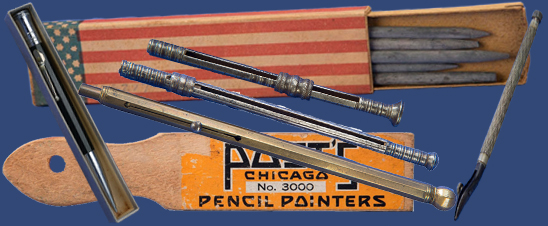This set of four short (less than 3-1/2") wood and graphite pencils is in a rectangular white cardboard box. The pencils are marked: VENUS AMERICAN (/) PENCIL CO. N.Y. They are also marked with the hardness of their leads: HB, B, F, 4H.
- Description
-
This set of four short (less than 3-1/2") wood and graphite pencils is in a rectangular white cardboard box. The pencils are marked: VENUS AMERICAN (/) PENCIL CO. N.Y. They are also marked with the hardness of their leads: HB, B, F, 4H. These correspond to a chart of lead hardnesses that is on the top of the box. The chart is marked: "VENUS" PERFECT PENCILS: (/) Made in 17 Black and 2 Copying Degrees: (/) each degree guaranteed never to vary. (/) London. AMERICAN PENCIL CO., New York. Empty space in the box suggests it originally held five pencils.
-
The box also holds a 1" white rubber eraser marked: VENUS (/) AMERICAN PENCIL CO. (/) NEW YORK (/) No100. Next to the eraser is a 2-1/2" square wooden dowel covered in white paper marked: ←—— This Is The New VENUS ERASER Try It. The inside of the box lid has an advertisement for the eraser, which came in twelve sizes, ranging from four pieces in one box to 100 pieces in one box. The presence of the eraser suggests that this set was made after MA.330191.
-
The American Lead Pencil Company began operating in New York City around 1861 and started to manufacture the Venus line of drawing pencils in 1905. By 1939 the firm was advertising itself as the American Pencil Co. Various retailers in the United States, including Keuffel & Esser and the Eugene Dietzgen Co., offered the Venus line from the 1930s to the 1960s. In 1956 American Pencil Co. changed its name to Venus Pen and Pencil to reflect its popular brand. Faber-Castell USA purchased the firm in 1973.
-
The owner of these pencils, Mendel Lazear Peterson (1918–2003), earned degrees from the University of Southern Mississippi and Vanderbilt University. He joined the U.S. Navy in 1943 and served in the Pacific theater, where he developed an interest in underwater archaeology. He remained in the service after World War II. From 1958 to 1973, he was a Smithsonian curator in historic archaeology and armed forces history. He likely acquired the pencils during his military career.
-
References: D. B. Smith, "Venus Drawing Pencil," http://leadholder.com/wood-venus.html; Bart Barnes, "Smithsonian's Mendel Peterson Dies," Washington Post, August 28, 2003.
- Location
-
Currently not on view
- date made
-
1939-1956
- maker
-
American Lead Pencil Company
- ID Number
-
MA.330192
- accession number
-
288888
- catalog number
-
330192
